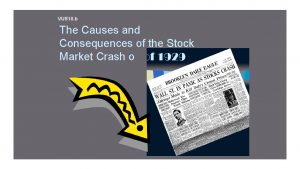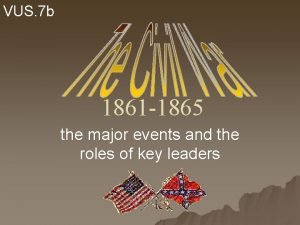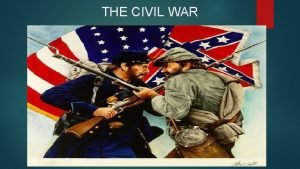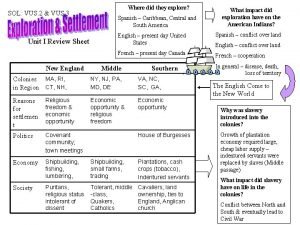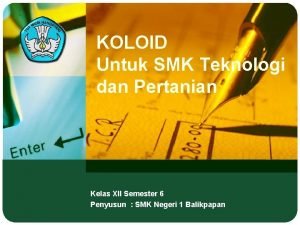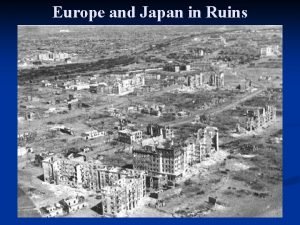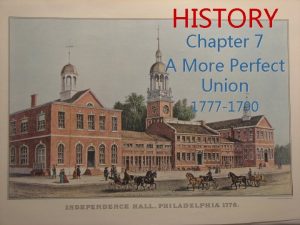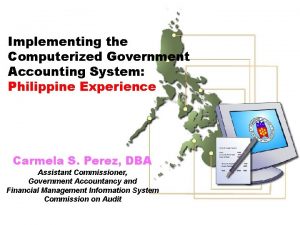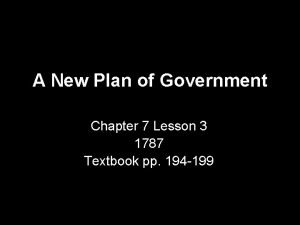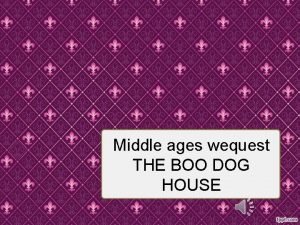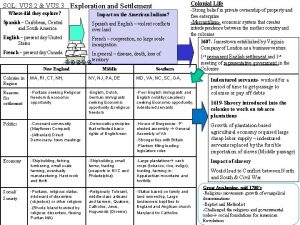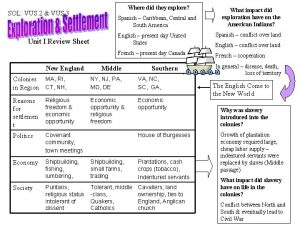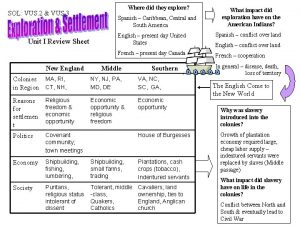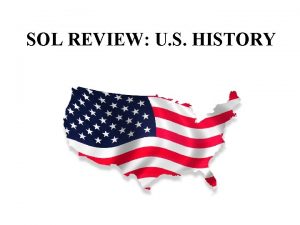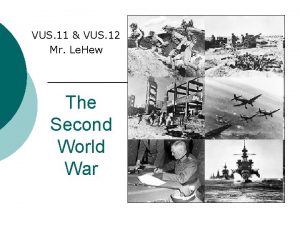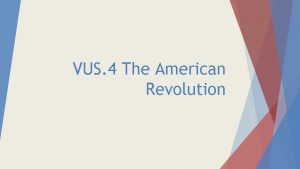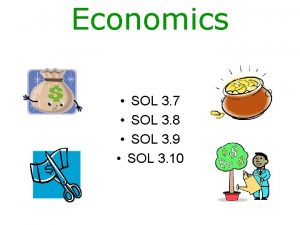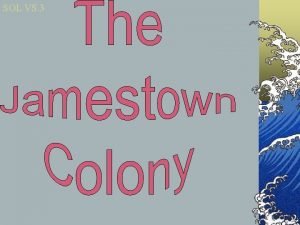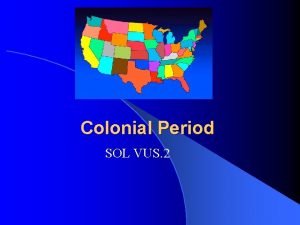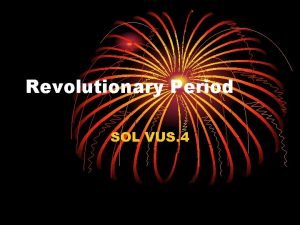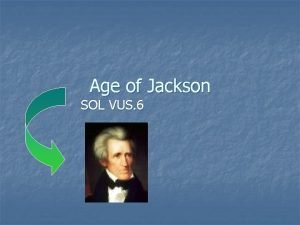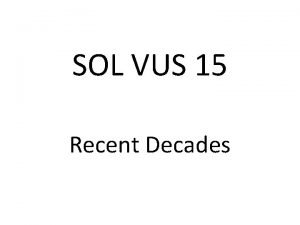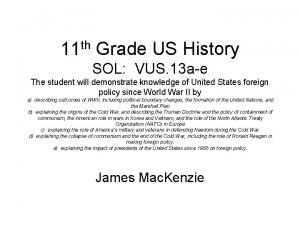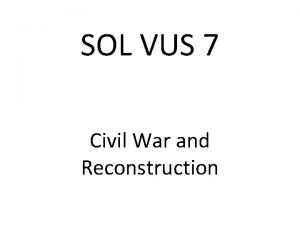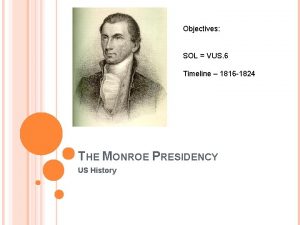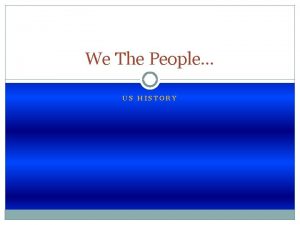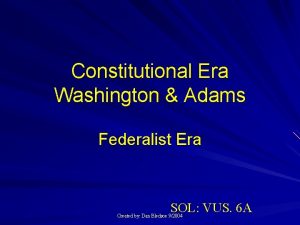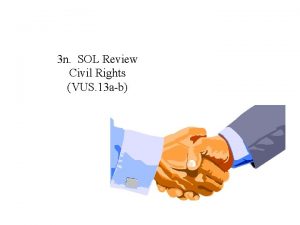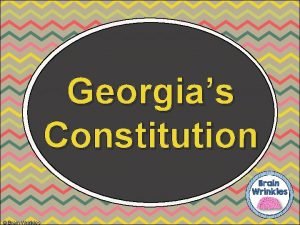SOL VUS 5 The New Government The Constitution




































- Slides: 36

SOL VUS 5 The New Government – The Constitution of the United States

Confederation and Constitution The Americans made two attempts to establish a workable government based on republican ideals: Articles of Confederation and the Constitution.

Attempts at a New Government Fearful of a powerful central government like England’s, America’s political leaders created the Articles of Confederation.

The Articles of Confederation • Provided for a weak national government • Gave Congress no power to tax or regulate commerce (trade) among the states • Provided for no common currency • Gave each state one vote regardless of size • Provided for no executive or judicial branch

Weaknesses of the Articles of Confederation A weak national government Congress could not tax or regulate commerce among states No common currency Just one vote per state, size didn’t matter No executive or judicial branch

The Making of the Constitution • The second government was the Constitution of the United States which established a government that: – Shared power between the national government and state governments = federalism. – Protected the rights of states – Provided a system for orderly change through amendments to the Constitution itself.

The Making of the Constitution Key issues and their resolutions Federal laws are supreme when constitutional but the states have considerable power to govern themselves. Enumerated, Shared, or Reserved Powers The power of taxes g n i t c e l l Co erce m m o c g Regulatin ar Declare w maintain Army & Navy Do what is necessary and proper to carry out duties. Congress was limited to those identified in the Constitution = Enumerated Powers


Checks and Balances Avoided a too-powerful central government by establishing three co-equal branches—legislative, executive, and judicial • With numerous checks and balances among them • Limited the powers of the federal government to those identified in the Constitution

Key Issues Resolution Power was balanced between large and small states by creating a Senate with equal representation and a House of Representatives with members based on population There can be Each state has 2 Senators several Representatives from large state

Do Slaves Count in the “Population”? To please Southern slave-holding states, 3/5 of slaves were able to be counted when determining the number of Representatives. = The Three-fifths Compromise

U. S. Constitution

Checks & Balances

The Making of the Constitution • Key leaders • George Washington, a Virginian, was president of the Convention He presided at the Convention, and although seldom participating in the debates, lent his enormous prestige to the proceedings.

The Making of the Constitution • Key leaders • James Madison, “Father of the Constitution” • Madison, a Virginian and the writer of the “ Virginia Plan, ” kept copious notes of the proceedings. He wrote the Bill of Rights.

Bill of Rights—Virginia’s Contributions George Mason wrote the Virginia Declaration of Rights. It held the basic idea that human rights should not be violated by government. Thomas Jefferson wrote the Virginia Statute for Religious Freedom. It outlawed the “established church” or the support of government for one favored church.

Virginia Statute of Religious Freedom

Principles of the Bill of Rights was based on… • The major principles of the Bill of Rights of the Constitution were based on earlier Virginia statutes. – Virginia Declaration of Rights (George Mason) Reiterated the notion that basic human rights should not be violated by governments – Virginia Statute for Religious Freedom (Thomas Jefferson) Outlawed the established church—that is, the practice of government support for one favored church – Sum It Up James Madison consulted the Virginia Declaration of Rights and the Virginia Statute for Religious Freedom when drafting the amendments that eventually became the United States Bill of Rights.

• The Constitution was a “bundle of compromises” among the framers who held a variety of political beliefs • Two “sides” emerged from the Convention, those who supported ratification (Federalists) and those opposed (Anti-Federalists) • Elements of Federalist and Anti-Federalist thought are reflected in contemporary political debate on issues such as the size and role of government, federalism, and the protection of individual rights.

• Federalists advocated the importance of a strong central government, especially to promote economic development and public improvements. • Today, those who see a primary role for the federal government in solving national problems are heirs to this tradition.

• Anti-Federalists feared an overly powerful central government destructive of the rights of individuals and the prerogatives of the states. • Today, the more conservative thinkers echo these concerns and champion liberty, individual initiative, and free markets.

• The leading Virginia opponents of ratification were Patrick Henry (“Give me Liberty or Give me Death”) and George Mason • The leading Virginia proponents of ratification were George Washington and James Madison.

Ratification rge Geo ington h Was s Jame on is Mad Georg e Maso n Patrick Henry

V.

• Important legal precedents established by the Marshall Court strengthened the United States Supreme Court as an equal branch of the national government. John Marshall Chief Justice of the Supreme Court – The doctrine of judicial review set forth in Marbury v. Madison – The doctrine of implied powers set forth in Mc. Culloch v. Maryland – A broadly national view of economic affairs and interstate commerce set forth in Gibbons v. Ogden • All are the foundation blocks of the Supreme Court’s authority to mediate disagreements between branches of governments, levels of government, and competing business interests.

Complete the following:

I. Marbury v Madison 1803 A. Prior to Adams leaving office Congress (Federalist dominated) tried to assert power over the Judicial Branch B. Judiciary Act of 1801 1. Created 16 new federal judgeships 2. Adams approves appointments during last days as president 3. Became known as the “Midnight Judges” 4. Way Adams (Federalists) could protect country against Jefferson’s ideals

I. Marbury v Madison 1803 cont C. William Marbury (“midnight judge”) D. Appointed by Adams to serve in Washington, D. C. E. James Madison the Secretary of State 1. Refuses to allow Marbury his bench 2. Marbury refuses to step down 3. Madison asks Supreme Court to step in

I. Marbury v Madison 1803 cont F. John Marshall-Chief Justice (appointed by Adams) 1. Federalist from VA 2. Acted on over 500 cases G. Marbury v Madison ruling 1. Marbury had right to judge position 2. Supreme Court could only hear cases on appeal 3. Declare part of Judiciary Act of 1789 unconstitutional

I. Marbury v Madison 1803 cont H. Established the principal of judicial review-federal courts have the power to declare laws unconstitutional

II. Mc. Culloch v Maryland 1816 A. Court case over the Second National Bank 1. Maryland tried to destroy the National Bank by taxing the National Bank to protect its states banks B. National Bank refused to pay taxes and sued the state of Maryland

II. Mc. Culloch v Maryland 1816 (cont) C. Supreme Court Issues 1. Was the Bank constitutional? 2. Did Maryland have right to tax National Bank? D. Court ruling (Chief Justice Marshall) 1. Bank was constitutional (falls under “necessary and proper” clause) 2. Maryland (states) could NOT tax National Bank a. “Power to tax is the power to destroy” b. States could not take away national powers

• “Doctrine of Implied Powers” = “Necessary and Proper” Clause

III. Gibbons v. Ogden, 1824 • Called the “Steamboat Case”, this Supreme Court Case was over the state of New York attempting to give a monopoly of water-borne commerce between New York and New Jersey. • Marshall ruled that only Congress and the Federal Government can govern interstate commerce. • This weakened states’ rights and strengthened the powers/rights of the federal government.

Case Foundations Today Marbury v. Madison Gibbons v. Ogden Mc. Culloch v. Maryland The above three cases laid the foundation for the Court’s authority to mediate disagreements between --branches of government, --levels of government and --competing business interests.

Essential Questions: 1. 2. 3. 4. 5. 6. 7. 8. How did America’s pre-Revolutionary relationship with England influence the structure of the first national government? What weaknesses in the Articles of Confederation led to the effort to draft a new constitution? How did the delegates to the Constitutional Convention balance competing interests? What were the compromises from the Constitutional Convention? How was the Bill of Rights influenced by the VA Declaration of Rights and the VA Statute for Religious Freedom? What were the major arguments for and against the Constitution of 1787 in leading Federalist and Anti-Federalist writings and in the ratification debates? Who were the leading Federalists and Anti-Federalists in the pivotal ratification debate in Virginia? How did Chief Justice John Marshall, a Virginian, contribute to the growth of the US Supreme Court’s importance in relation to other branches of the national government?
 Texas constitution vs u.s. constitution venn diagram
Texas constitution vs u.s. constitution venn diagram Nc constitution vs us constitution
Nc constitution vs us constitution Constitution what is constitution
Constitution what is constitution Lesson 1 principles of the constitution
Lesson 1 principles of the constitution Greyhound vus
Greyhound vus Vus.10b when was the stock market crash?
Vus.10b when was the stock market crash? Vus 7a what event sparked secession of the southern states?
Vus 7a what event sparked secession of the southern states? The civil war
The civil war Vus review
Vus review Perbedaan sol liofil dan sol liofob
Perbedaan sol liofil dan sol liofob 6 principles of the constitution
6 principles of the constitution The constitution lesson 2 the three branches of government
The constitution lesson 2 the three branches of government Note three ways war affected the land and people of europe.
Note three ways war affected the land and people of europe. Chapter 7 lesson 2 forging a new constitution
Chapter 7 lesson 2 forging a new constitution State and federal constitutions
State and federal constitutions Electronic new government accounting system
Electronic new government accounting system Lesson 3 a new plan of government
Lesson 3 a new plan of government During the middle ages noblewomen had
During the middle ages noblewomen had Hierarchy chart of new france government
Hierarchy chart of new france government Hát kết hợp bộ gõ cơ thể
Hát kết hợp bộ gõ cơ thể Bổ thể
Bổ thể Tỉ lệ cơ thể trẻ em
Tỉ lệ cơ thể trẻ em Gấu đi như thế nào
Gấu đi như thế nào Tư thế worms-breton
Tư thế worms-breton Alleluia hat len nguoi oi
Alleluia hat len nguoi oi Các môn thể thao bắt đầu bằng tiếng nhảy
Các môn thể thao bắt đầu bằng tiếng nhảy Thế nào là hệ số cao nhất
Thế nào là hệ số cao nhất Các châu lục và đại dương trên thế giới
Các châu lục và đại dương trên thế giới Công thức tính thế năng
Công thức tính thế năng Trời xanh đây là của chúng ta thể thơ
Trời xanh đây là của chúng ta thể thơ Mật thư tọa độ 5x5
Mật thư tọa độ 5x5 Làm thế nào để 102-1=99
Làm thế nào để 102-1=99 Phản ứng thế ankan
Phản ứng thế ankan Các châu lục và đại dương trên thế giới
Các châu lục và đại dương trên thế giới Thơ thất ngôn tứ tuyệt đường luật
Thơ thất ngôn tứ tuyệt đường luật Quá trình desamine hóa có thể tạo ra
Quá trình desamine hóa có thể tạo ra





